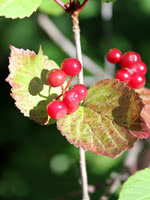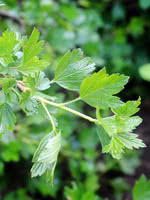Mon-Fri 9am - 5pm Mountain time
Lowbush Cranberry vs Northern Gooseberry
Viburnum edule
Ribes oxyacanthoides
NOT AVAILABLE THIS SEASON - MIGHT RETURN
NOT AVAILABLE THIS SEASON - MIGHT RETURN
Lowbush Cranberry is a short, deciduous shrub native to North America. Its white flowers bear sour but edible fruit that ripens to a brilliant red in fall. Lowbush Cranberry's small size makes it suitable for urban use; buyers will also find it useful if trying to reclaim land back to its original species or when landscaping with native species in damp conditions.
Northern Gooseberry is a small, ornamental quality native shrub with prickly stems. You can plant it anywhere you'd plant Prickly Rose or Common Wild Rose, such as your yard.
Most people find Northern Gooseberry berries a bit tart for significant fresh eating but they are good for baking, wine or jam.

